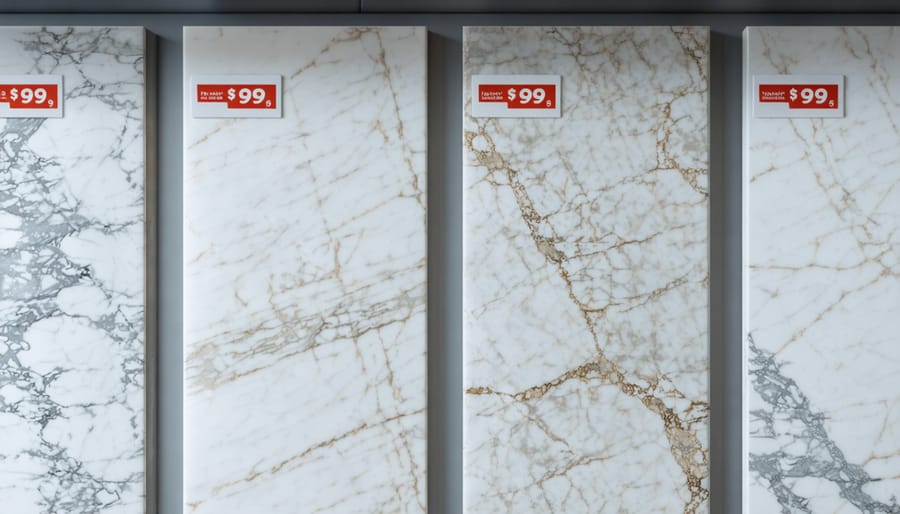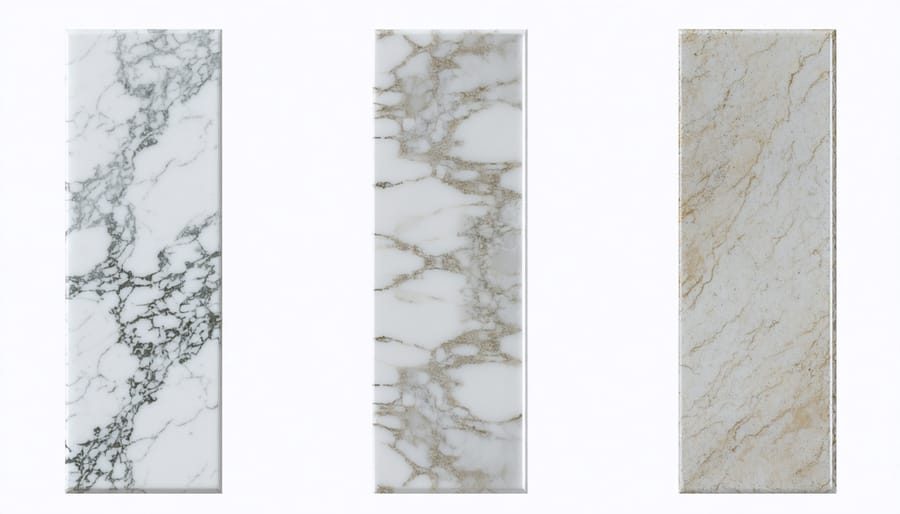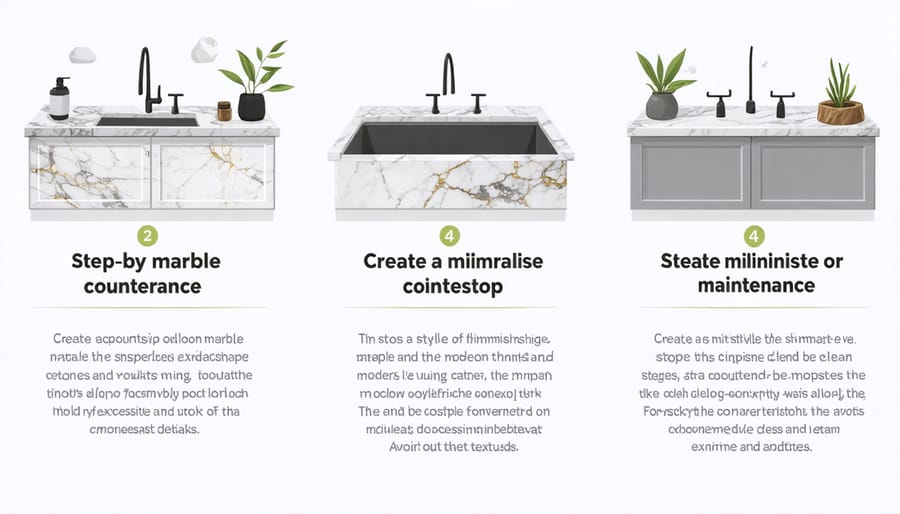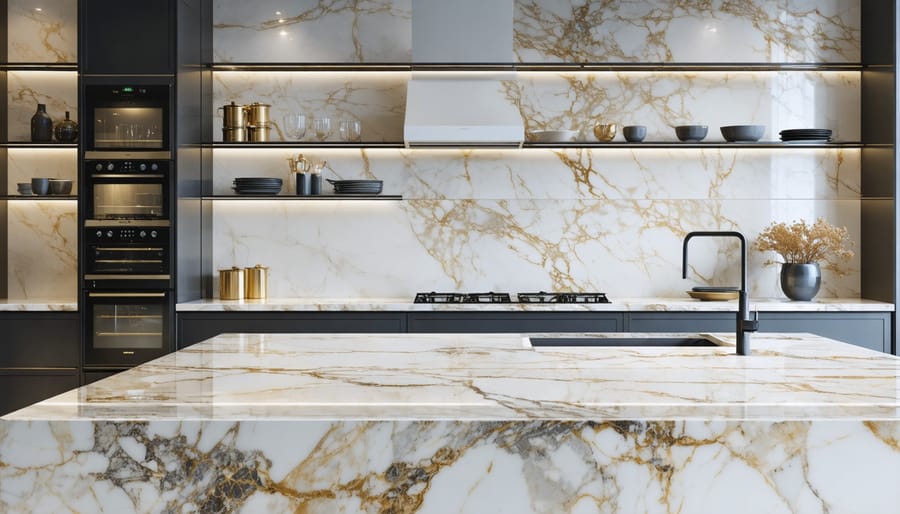Marble countertops typically cost between $40 to $200 per square foot installed, with most homeowners spending $2,000 to $7,000 for their entire project. This luxurious natural stone’s pricing varies dramatically based on marble quality, origin, and complexity of installation. Premium varieties like Calacatta or Statuario can exceed $300 per square foot, while more common Carrara marble starts around $40 per square foot.
Beyond material costs, installation expenses typically add $10-30 per square foot, while edge treatments, sealing, and structural reinforcement can increase the total investment by 15-30%. Understanding these cost factors is crucial for budgeting accurately and avoiding unexpected expenses during your kitchen or bathroom renovation.
A standard 40-square-foot kitchen counter project using mid-grade marble typically ranges from $3,000 to $5,000 complete. This investment delivers unmatched elegance and durability, though proper maintenance is essential to protect your marble’s value and appearance over time.
Average Marble Countertop Costs

Material Costs
Marble countertop material costs vary significantly based on the type and quality of stone selected. Carrara marble, the most common and affordable option, typically ranges from $40 to $75 per square foot. This classic Italian marble features a white or blue-gray background with soft, feathery veining.
Moving up the price scale, Calacatta marble commands $100 to $200 per square foot due to its distinctive bold veining patterns and rarer availability. Statuary marble, prized for its crystalline white background and dramatic veining, falls within a similar premium range.
For luxury projects, exotic varieties like Breccia Paradiso ($150-$250 per square foot) or Portoro marble ($200-$300 per square foot) offer unique colorations and patterns. These high-end options are often sourced from exclusive quarries and feature distinctive characteristics like gold veining or deep black backgrounds.
The grade of the marble also impacts pricing. Grade A marble (highest quality) costs 15-30% more than Grade B or C alternatives. Factors determining grade include the stone’s density, porosity, and the presence of natural imperfections.
When budgeting, remember that most suppliers sell marble in slabs, typically 40-50 square feet each. This may require purchasing more material than your exact measurements to accommodate seams and potential waste during fabrication. Prices can fluctuate based on market availability and seasonal demand.
Installation Costs
Installation costs for marble countertops typically range from $500 to $1,500, depending on your location and project complexity. The marble countertop installation process requires skilled professionals and specialized equipment, which significantly influences the final cost.
Labor charges usually account for $30 to $45 per square foot. This includes initial measurements, template creation, cutting, and final installation. Additional expenses often include:
– Edge treatment and finishing: $10-30 per linear foot
– Sink cutouts: $100-300 per cutout
– Seaming: $200-400 per seam
– Removal of existing countertops: $200-500
– Plumbing disconnection and reconnection: $150-300
Several factors can increase installation costs:
– Complex layouts requiring multiple seams
– Irregular shapes or curved sections
– Reinforcement for overhang support
– Accessibility challenges
– Special edge treatments or inlays
To manage installation costs effectively, ensure accurate measurements and a clear scope of work before hiring contractors. Some companies include installation in their square footage pricing, while others charge separately. Always get detailed quotes that specify all potential charges and ask about warranty coverage for both materials and workmanship.
Factors Affecting Marble Countertop Prices
Marble Quality and Origin
The price of marble countertops varies significantly based on the stone’s quality and origin. When choosing the right marble type, you’ll find that Italian Carrara marble typically ranges from $40 to $100 per square foot, while premium varieties like Calacatta can cost $180 to $250 per square foot. The source location impacts both quality and cost, with Italian marble generally commanding higher prices due to its superior veining and historical prestige.
Grade A marble, characterized by consistent coloring and minimal imperfections, demands premium pricing but offers better durability and aesthetic appeal. Grade B and C marbles, while more affordable, may show more variations and natural flaws. The stone’s thickness also affects pricing, with standard 2cm slabs costing less than premium 3cm options.
Color variations play a crucial role in pricing. White and light-colored marbles tend to be more expensive due to their popularity and limited availability. Unique patterns and rare color combinations can significantly increase the price, particularly for luxury varieties from specific quarries in Italy, Greece, or Spain.
Edge Profiles and Finishes
Edge profiles and finishes significantly impact your marble countertop’s final cost, typically adding $10 to $40 per linear foot to your project. Basic edges like straight (eased) or quarter round are usually included in the base price, while more elaborate profiles command premium rates.
Premium edge treatments such as ogee ($25-30 per linear foot), waterfall ($30-35), or bullnose ($20-25) require additional fabrication time and expertise. Decorative edges like rope or dupont can push costs up to $35-40 per linear foot due to their intricate detailing.
Surface finishes also affect pricing. A polished finish, which creates the classic glossy look, is typically included in standard pricing. However, specialty finishes like honed (matte), leathered, or brushed can add $5-15 per square foot to your total. These alternative finishes not only impact aesthetics but also affect maintenance requirements and durability.
Consider that more complex edge profiles may require additional maintenance over time and can be more susceptible to chipping. When budgeting, factor in both the immediate cost increase and long-term maintenance implications of your chosen profile and finish.

Project Complexity
The complexity of your marble countertop project significantly influences the final cost. Larger installations naturally require more material and labor, but it’s the intricacy of the design that can really impact your budget. Simple rectangular layouts with straight cuts typically cost less, while complex designs with multiple angles and corners increase labor costs by 10-20%.
Special features like decorative edges can add $20-40 per linear foot to your project. Common edge profiles like eased or bullnose are usually included in base pricing, but more elaborate options such as ogee or waterfall edges command premium rates. Cutouts for sinks, faucets, and cooktops also affect pricing, with each standard cutout typically costing $100-200.
Island installations often require larger slabs and special reinforcement, potentially increasing costs by 15-25%. If your design includes seams, skilled fabricators must carefully match patterns and veining, which adds to labor costs. Premium finishing touches like integrated drainboards or custom backsplashes can add several hundred dollars to the project.
The thickness of your marble also plays a role, with standard 2cm (¾ inch) slabs costing less than thicker 3cm (1¼ inch) options. Some designs may require additional support or reinforcement, particularly for overhangs or suspended sections, which can add $200-500 to the total cost depending on the complexity.
Hidden Costs to Consider
Maintenance and Sealing
To properly maintain your marble countertops and protect your investment, you’ll need to factor in ongoing maintenance costs. Marble requires regular sealing to prevent staining and etching, typically every 6-12 months depending on usage. Professional sealing services range from $200 to $400 per application, though DIY sealing kits cost between $25 and $50.
Daily maintenance involves using pH-neutral cleaners specifically designed for natural stone, which cost approximately $15-30 per bottle. Avoid acidic cleaners, as these can damage the surface. You’ll also need microfiber cloths and stone-safe cleaning pads, adding about $20-30 annually to your maintenance budget.
Over time, marble may require professional polishing to remove etching and restore its shine. This service typically costs $200-500, depending on the countertop size and condition. Major repairs, such as crack filling or chip repair, can range from $200-800 per incident.
To minimize long-term costs, consider purchasing a maintenance kit that includes sealer, cleaner, and polishing supplies for about $75-100. While these ongoing expenses add to your initial investment, proper maintenance ensures your marble countertops retain their beauty and value for decades to come.

Preparation and Removal
Before installing new marble countertops, you’ll need to factor in the costs of removing existing countertops and preparing the space. Removal typically costs between $200 to $500, depending on your current countertop material and size. Contractors usually charge $40 to $70 per hour for removal work, with most jobs taking 3-5 hours to complete.
If your existing countertops are particularly heavy (like granite) or attached with strong adhesives, removal costs might increase due to additional labor and equipment needs. Some contractors may charge extra for disposing of old materials, typically $100-$200 for disposal fees.
Preparation work is crucial for proper marble installation and includes:
– Ensuring cabinet bases are level and structurally sound ($100-$300)
– Reinforcing support structures if needed ($200-$500)
– Plumbing disconnection and reconnection ($150-$300)
– Electrical modifications if required ($200-$400)
Some homes, especially older ones, may need additional preparation work. Common issues include:
– Addressing uneven walls
– Fixing cabinet alignment problems
– Updating plumbing fixtures
– Modifying electrical outlets
It’s recommended to budget an additional 10-15% of your total project cost for unexpected preparation needs. Most contractors will include a detailed breakdown of removal and preparation costs in their initial quote, but always ask for specifics to avoid surprises later.
Cost-Saving Tips
While marble countertops are a premium choice, there are several strategic ways to manage costs without sacrificing quality. One effective approach is to consider budget-friendly countertop options like using marble for smaller sections while combining it with other materials for less visible areas.
Choose Grade B or C marble for less frequently used spaces, reserving Grade A for focal points like kitchen islands. These grades offer similar durability at a lower price point. Opt for thinner slabs (2cm instead of 3cm) where structural support allows, potentially saving 20-30% on material costs.
Consider remnants from stone yards for smaller projects or bathroom vanities. These pre-cut pieces often sell for 40-50% less than full slabs. Selecting readily available marble varieties like Carrara instead of rare options can significantly reduce costs, sometimes by up to 30%.
The edge profile choice impacts pricing substantially. Simple eased or straight edges cost less than elaborate ogee or waterfall edges. Keep the design straightforward to minimize fabrication costs. Timing your purchase during off-peak seasons (typically winter months) can result in better deals and potential discounts from suppliers.
Work directly with fabricators rather than retail middlemen, and request quotes from multiple suppliers. Some fabricators offer package deals that include installation, which can be more cost-effective than hiring separate contractors. Remember to factor in maintenance costs – choosing a more durable marble variety initially might save money on long-term care and repairs.
Investing in marble countertops represents a significant decision that requires careful consideration of multiple factors. As we’ve explored, the cost typically ranges from $40 to $200 per square foot installed, with most homeowners spending between $2,000 and $8,000 for their entire project. The final price depends heavily on marble type, quality, thickness, edge treatments, and installation complexity.
Remember that while initial costs may seem high, marble countertops can add substantial value to your home and last for decades when properly maintained. Consider not just the upfront expense but also long-term maintenance costs, including regular sealing and professional cleaning.
To make the most cost-effective decision, we recommend getting multiple quotes from reputable contractors, carefully selecting your marble variety, and being strategic about slab usage to minimize waste. Don’t forget to factor in additional costs such as removal of existing countertops, edge treatments, and any necessary structural reinforcement.
Quality installation is paramount – while it may be tempting to cut costs on labor, proper installation ensures your marble countertops will perform well and maintain their beauty for years to come. Consider timing your purchase during off-peak seasons or looking for remnants if working with a smaller space.
Whether you choose classic Carrara or luxurious Calacatta, understanding these cost factors will help you make an informed decision that balances your aesthetic preferences with your budget constraints.










